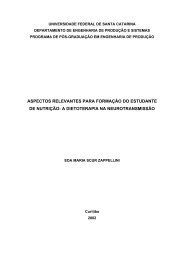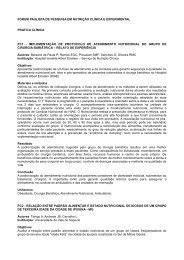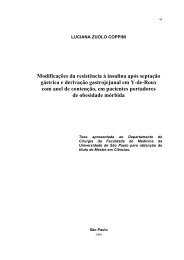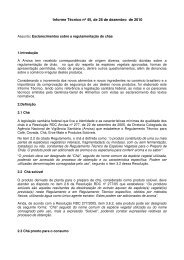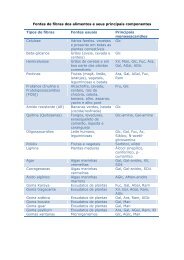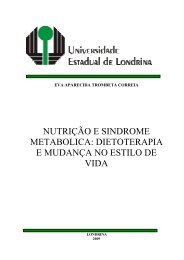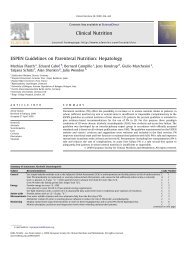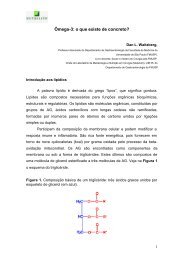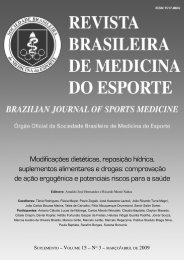- Page 1 and 2: Guidelines onfood
- Page 4: Guidelines onfood
- Page 7 and 8: GUIDELINES ON FOOD FORTIFICATION WI
- Page 9 and 10: GUIDELINES ON FOOD FORTIFICATION WI
- Page 11 and 12: GUIDELINES ON FOOD FORTIFICATION WI
- Page 13 and 14: List of tablesTable 1.1 Prevalence
- Page 15 and 16: GUIDELINES ON FOOD FORTIFICATION WI
- Page 17 and 18: ForewordInterest in micronutrient m
- Page 19 and 20: GUIDELINES ON FOOD FORTIFICATION WI
- Page 21 and 22: PrefaceMore than 2 billion people i
- Page 23 and 24: GUIDELINES ON FOOD FORTIFICATION WI
- Page 25 and 26: GUIDELINES ON FOOD FORTIFICATION WI
- Page 27 and 28: AbbreviationsAICDCCHDDALYDFEDRIDRVE
- Page 29 and 30: GlossaryThe Average Intake (AI) is
- Page 31 and 32: GUIDELINES ON FOOD FORTIFICATION WI
- Page 34: PA RT IThe role of food fortificati
- Page 39 and 40: GUIDELINES ON FOOD FORTIFICATION WI
- Page 41 and 42: GUIDELINES ON FOOD FORTIFICATION WI
- Page 43 and 44: GUIDELINES ON FOOD FORTIFICATION WI
- Page 45 and 46: GUIDELINES ON FOOD FORTIFICATION WI
- Page 47 and 48: GUIDELINES ON FOOD FORTIFICATION WI
- Page 49 and 50: GUIDELINES ON FOOD FORTIFICATION WI
- Page 51 and 52: GUIDELINES ON FOOD FORTIFICATION WI
- Page 53 and 54: GUIDELINES ON FOOD FORTIFICATION WI
- Page 55 and 56: GUIDELINES ON FOOD FORTIFICATION WI
- Page 57 and 58: CHAPTER 2Food fortification: basic
- Page 59 and 60: GUIDELINES ON FOOD FORTIFICATION WI
- Page 61 and 62: GUIDELINES ON FOOD FORTIFICATION WI
- Page 63 and 64: GUIDELINES ON FOOD FORTIFICATION WI
- Page 65 and 66: GUIDELINES ON FOOD FORTIFICATION WI
- Page 67 and 68: GUIDELINES ON FOOD FORTIFICATION WI
- Page 69 and 70: GUIDELINES ON FOOD FORTIFICATION WI
- Page 72: PA RT I IEvaluating the publichealt
- Page 75 and 76: GUIDELINES ON FOOD FORTIFICATION WI
- Page 77 and 78: GUIDELINES ON FOOD FORTIFICATION WI
- Page 79 and 80: GUIDELINES ON FOOD FORTIFICATION WI
- Page 81 and 82: GUIDELINES ON FOOD FORTIFICATION WI
- Page 83 and 84: GUIDELINES ON FOOD FORTIFICATION WI
- Page 85 and 86:
GUIDELINES ON FOOD FORTIFICATION WI
- Page 87 and 88:
GUIDELINES ON FOOD FORTIFICATION WI
- Page 89 and 90:
GUIDELINES ON FOOD FORTIFICATION WI
- Page 91 and 92:
GUIDELINES ON FOOD FORTIFICATION WI
- Page 93 and 94:
GUIDELINES ON FOOD FORTIFICATION WI
- Page 95 and 96:
GUIDELINES ON FOOD FORTIFICATION WI
- Page 97 and 98:
GUIDELINES ON FOOD FORTIFICATION WI
- Page 99 and 100:
GUIDELINES ON FOOD FORTIFICATION WI
- Page 101 and 102:
GUIDELINES ON FOOD FORTIFICATION WI
- Page 103 and 104:
GUIDELINES ON FOOD FORTIFICATION WI
- Page 105 and 106:
GUIDELINES ON FOOD FORTIFICATION WI
- Page 107 and 108:
GUIDELINES ON FOOD FORTIFICATION WI
- Page 109 and 110:
GUIDELINES ON FOOD FORTIFICATION WI
- Page 111 and 112:
GUIDELINES ON FOOD FORTIFICATION WI
- Page 113 and 114:
GUIDELINES ON FOOD FORTIFICATION WI
- Page 115 and 116:
GUIDELINES ON FOOD FORTIFICATION WI
- Page 117 and 118:
GUIDELINES ON FOOD FORTIFICATION WI
- Page 119 and 120:
GUIDELINES ON FOOD FORTIFICATION WI
- Page 121 and 122:
GUIDELINES ON FOOD FORTIFICATION WI
- Page 123 and 124:
GUIDELINES ON FOOD FORTIFICATION WI
- Page 125 and 126:
GUIDELINES ON FOOD FORTIFICATION WI
- Page 128 and 129:
IntroductionBy providing a critical
- Page 130 and 131:
CHAPTER 5Iron, vitamin A and iodine
- Page 132 and 133:
5. IRON, VITAMIN A AND IODINEto phy
- Page 134 and 135:
5. IRON, VITAMIN A AND IODINEdiet,
- Page 136 and 137:
5. IRON, VITAMIN A AND IODINEcompou
- Page 138 and 139:
5. IRON, VITAMIN A AND IODINETABLE
- Page 140 and 141:
5. IRON, VITAMIN A AND IODINEtortil
- Page 142 and 143:
5. IRON, VITAMIN A AND IODINEnumber
- Page 144 and 145:
5. IRON, VITAMIN A AND IODINEstool
- Page 146 and 147:
5. IRON, VITAMIN A AND IODINETABLE
- Page 148 and 149:
5. IRON, VITAMIN A AND IODINEvitami
- Page 150 and 151:
5. IRON, VITAMIN A AND IODINE— in
- Page 152 and 153:
5. IRON, VITAMIN A AND IODINEiodine
- Page 154 and 155:
5. IRON, VITAMIN A AND IODINEdevelo
- Page 156 and 157:
5. IRON, VITAMIN A AND IODINEhypert
- Page 158 and 159:
6. ZINC, B VITAMINS, VITAMINS C AND
- Page 160 and 161:
6. ZINC, B VITAMINS, VITAMINS C AND
- Page 162 and 163:
6. ZINC, B VITAMINS, VITAMINS C AND
- Page 164 and 165:
6. ZINC, B VITAMINS, VITAMINS C AND
- Page 166 and 167:
6. ZINC, B VITAMINS, VITAMINS C AND
- Page 168:
PA RT I VImplementing effectiveand
- Page 171 and 172:
GUIDELINES ON FOOD FORTIFICATION WI
- Page 173 and 174:
GUIDELINES ON FOOD FORTIFICATION WI
- Page 175 and 176:
GUIDELINES ON FOOD FORTIFICATION WI
- Page 177 and 178:
GUIDELINES ON FOOD FORTIFICATION WI
- Page 179 and 180:
GUIDELINES ON FOOD FORTIFICATION WI
- Page 181 and 182:
GUIDELINES ON FOOD FORTIFICATION WI
- Page 183 and 184:
GUIDELINES ON FOOD FORTIFICATION WI
- Page 185 and 186:
GUIDELINES ON FOOD FORTIFICATION WI
- Page 187 and 188:
GUIDELINES ON FOOD FORTIFICATION WI
- Page 189 and 190:
GUIDELINES ON FOOD FORTIFICATION WI
- Page 191 and 192:
GUIDELINES ON FOOD FORTIFICATION WI
- Page 193 and 194:
GUIDELINES ON FOOD FORTIFICATION WI
- Page 195 and 196:
GUIDELINES ON FOOD FORTIFICATION WI
- Page 197 and 198:
GUIDELINES ON FOOD FORTIFICATION WI
- Page 199 and 200:
GUIDELINES ON FOOD FORTIFICATION WI
- Page 201 and 202:
GUIDELINES ON FOOD FORTIFICATION WI
- Page 203 and 204:
GUIDELINES ON FOOD FORTIFICATION WI
- Page 205 and 206:
GUIDELINES ON FOOD FORTIFICATION WI
- Page 207 and 208:
GUIDELINES ON FOOD FORTIFICATION WI
- Page 209 and 210:
GUIDELINES ON FOOD FORTIFICATION WI
- Page 211 and 212:
CHAPTER 8Monitoring and evaluationM
- Page 213 and 214:
GUIDELINES ON FOOD FORTIFICATION WI
- Page 215 and 216:
GUIDELINES ON FOOD FORTIFICATION WI
- Page 217 and 218:
GUIDELINES ON FOOD FORTIFICATION WI
- Page 219 and 220:
GUIDELINES ON FOOD FORTIFICATION WI
- Page 221 and 222:
GUIDELINES ON FOOD FORTIFICATION WI
- Page 223 and 224:
GUIDELINES ON FOOD FORTIFICATION WI
- Page 225 and 226:
GUIDELINES ON FOOD FORTIFICATION WI
- Page 227 and 228:
GUIDELINES ON FOOD FORTIFICATION WI
- Page 229 and 230:
GUIDELINES ON FOOD FORTIFICATION WI
- Page 231 and 232:
GUIDELINES ON FOOD FORTIFICATION WI
- Page 233 and 234:
GUIDELINES ON FOOD FORTIFICATION WI
- Page 235 and 236:
GUIDELINES ON FOOD FORTIFICATION WI
- Page 237 and 238:
GUIDELINES ON FOOD FORTIFICATION WI
- Page 239 and 240:
GUIDELINES ON FOOD FORTIFICATION WI
- Page 241 and 242:
GUIDELINES ON FOOD FORTIFICATION WI
- Page 243 and 244:
GUIDELINES ON FOOD FORTIFICATION WI
- Page 245 and 246:
GUIDELINES ON FOOD FORTIFICATION WI
- Page 247 and 248:
GUIDELINES ON FOOD FORTIFICATION WI
- Page 249 and 250:
GUIDELINES ON FOOD FORTIFICATION WI
- Page 251 and 252:
GUIDELINES ON FOOD FORTIFICATION WI
- Page 253 and 254:
GUIDELINES ON FOOD FORTIFICATION WI
- Page 255 and 256:
GUIDELINES ON FOOD FORTIFICATION WI
- Page 257 and 258:
CHAPTER 10Communication, social mar
- Page 259 and 260:
GUIDELINES ON FOOD FORTIFICATION WI
- Page 261 and 262:
GUIDELINES ON FOOD FORTIFICATION WI
- Page 263 and 264:
GUIDELINES ON FOOD FORTIFICATION WI
- Page 265 and 266:
GUIDELINES ON FOOD FORTIFICATION WI
- Page 267 and 268:
GUIDELINES ON FOOD FORTIFICATION WI
- Page 269 and 270:
GUIDELINES ON FOOD FORTIFICATION WI
- Page 271 and 272:
GUIDELINES ON FOOD FORTIFICATION WI
- Page 273 and 274:
CHAPTER 11National food lawGovernme
- Page 275 and 276:
GUIDELINES ON FOOD FORTIFICATION WI
- Page 277 and 278:
GUIDELINES ON FOOD FORTIFICATION WI
- Page 279 and 280:
GUIDELINES ON FOOD FORTIFICATION WI
- Page 281 and 282:
GUIDELINES ON FOOD FORTIFICATION WI
- Page 283 and 284:
GUIDELINES ON FOOD FORTIFICATION WI
- Page 285 and 286:
GUIDELINES ON FOOD FORTIFICATION WI
- Page 287 and 288:
GUIDELINES ON FOOD FORTIFICATION WI
- Page 289 and 290:
GUIDELINES ON FOOD FORTIFICATION WI
- Page 291 and 292:
GUIDELINES ON FOOD FORTIFICATION WI
- Page 293 and 294:
GUIDELINES ON FOOD FORTIFICATION WI
- Page 295 and 296:
GUIDELINES ON FOOD FORTIFICATION WI
- Page 297 and 298:
GUIDELINES ON FOOD FORTIFICATION WI
- Page 299 and 300:
GUIDELINES ON FOOD FORTIFICATION WI
- Page 301 and 302:
GUIDELINES ON FOOD FORTIFICATION WI
- Page 303 and 304:
GUIDELINES ON FOOD FORTIFICATION WI
- Page 305 and 306:
GUIDELINES ON FOOD FORTIFICATION WI
- Page 307 and 308:
GUIDELINES ON FOOD FORTIFICATION WI
- Page 309 and 310:
GUIDELINES ON FOOD FORTIFICATION WI
- Page 311 and 312:
GUIDELINES ON FOOD FORTIFICATION WI
- Page 313 and 314:
Further readingPart I. The role of
- Page 315 and 316:
GUIDELINES ON FOOD FORTIFICATION WI
- Page 318 and 319:
ANNEX AIndicators for assessing pro
- Page 320 and 321:
ANNEX BThe international resource l
- Page 322 and 323:
B. THE INTERNATIONAL RESOURCE LABOR
- Page 324 and 325:
ANNEX CConversion factors for calcu
- Page 326 and 327:
C. CONVERSION FACTORS FOR CALCULATI
- Page 328 and 329:
D. A PROCEDURE FOR ESTIMATING FEASI
- Page 330 and 331:
D. A PROCEDURE FOR ESTIMATING FEASI
- Page 332 and 333:
D. A PROCEDURE FOR ESTIMATING FEASI
- Page 334 and 335:
D. A PROCEDURE FOR ESTIMATING FEASI
- Page 336 and 337:
D. A PROCEDURE FOR ESTIMATING FEASI
- Page 338 and 339:
D. A PROCEDURE FOR ESTIMATING FEASI
- Page 340 and 341:
D. A PROCEDURE FOR ESTIMATING FEASI
- Page 342 and 343:
D. A PROCEDURE FOR ESTIMATING FEASI
- Page 344 and 345:
D. A PROCEDURE FOR ESTIMATING FEASI
- Page 346 and 347:
ANNEX EA quality control monitoring
- Page 348 and 349:
E. A QUALITY CONTROL MONITORING SYS
- Page 350 and 351:
E. A QUALITY CONTROL MONITORING SYS
- Page 352 and 353:
F. THE CODEX ALIMENTARIUS AND THE W
- Page 354 and 355:
F. THE CODEX ALIMENTARIUS AND THE W
- Page 356 and 357:
F. THE CODEX ALIMENTARIUS AND THE W
- Page 358 and 359:
F. THE CODEX ALIMENTARIUS AND THE W
- Page 360 and 361:
F. THE CODEX ALIMENTARIUS AND THE W
- Page 362 and 363:
F. THE CODEX ALIMENTARIUS AND THE W
- Page 364 and 365:
IndexAdequate Intake (AI), 146Advoc
- Page 366 and 367:
INDEXLower Threshold Intake, 146Rec
- Page 368 and 369:
INDEXGambia, Theberiberi, 71calcium
- Page 370 and 371:
INDEXMalaysiaiodine fortification,
- Page 372 and 373:
INDEXKeshan Disease, 88prevalence o
- Page 374:
INDEXhealth consequences of, 84oste



